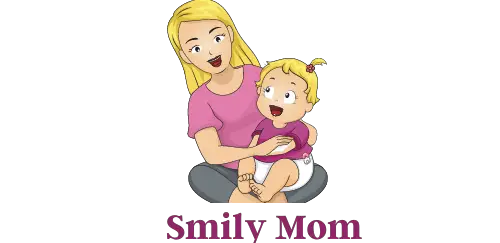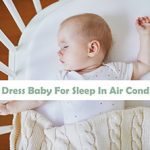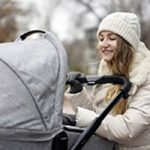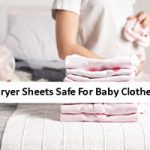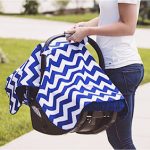On average, babies stop wearing onesies between 12-24 months. Although there’s no hard and fast rule as to how long a baby should wear onesies, most parents toss them out when babies start walking.
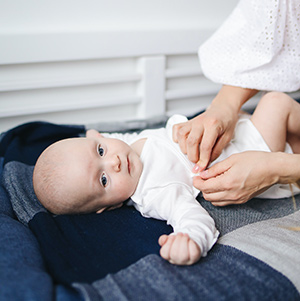
I can speak from my personal experience that onesies can be quite uncomfortable for babies when they start walking.
That’s not to dismiss the fact that onesies are a must-have item in a newborn’s wardrobe. They not only look adorable but also provide adequate all-weather comfort. For safety purpose, onesies should be your go-to choice of clothing when fitting a newborn in a car seat.
Even though bodysuits become sort of irrelevant after 24 months, your toddler can still continue to rock them.
A lot of manufacturers of size 2T and 3T bodysuits (which is the toddler size). So unless your toddler vehemently opposes the idea of wearing a onesies, there’s no reason why they can’t continue wearing them.
Diaper Changing and Onesies
The snap and closure design of onesies helps to keep diapers in place. As gross as it might sound, babies do have a tendency to stick their hands down their diapers.
The inquisitive nature of children can really take them to the wackiest of places. The zippered closure system at the bottom of onesies prevent babies from putting their hand in the nappy and make an unspeakable mess.
There’s just one caveat, though.
If the bodysuit is too tight-fitting, it can cause compression leaks, especially if you are using cloth diapers. If you only use cloth diapers, you might have to ditch the onesies sooner because as they grow up, or look for toddler size (2T and 3T) onesies.
You May Also Like: Can You Use Dryer Sheets on Baby Clothes?
The Convenience and Hygiene Offered by Onesies
The zip or snap-on closure and flaps at the bottom of onesies allow parents to pull it over the baby’s legs. In the event of a diaper mess, simply pulling the bodysuit down is way more hygienic than pulling it above the baby’s head.
The Warmth and Sleeping Comfort of Onesies
When babies begin to crawl around, a regular shirt will inevitably ride up at the back. This can trigger cold and flu, or worse, even pneumonia as babies are highly sensitive to extreme temperatures. Onesies don’t slide up or down, keeping the infant’s chest and belly warm in winter.
In warm to moderately cold weather, wearing the onesie alone should be enough. However, if the mercury drops too low, a long-sleeved onesie and a thick swaddling blanket or sleepsack would provide enough warmth without being too bulky.
Onesies and Walking
Changing the nappies and giving a change of clothes becomes increasingly difficult once babies learn to walk. Most babies start walking between 8-12 months. But for some kids, the onset of independent walking can occur as late as 18 months.
Expecting a one-year-old to lie down still while you change the nappy and outfit would be silly. It takes a while to make a child get in and out of a full-sleeve onesie.
For someone who refused to stay still even for a single second, stretchy pants and pull-up styles undies would make a more logical clothing choice.
Should Your Baby Wear Onesies Once Potty Training Begins?
Onesies are a big no no once your baby begins to potty train. At this stage, you should switch to potty training pants before graduating to normal pants. Onesies or bodysuits are meant for concealing the diaper.
Once the toilet training begins, your child will need easy-to-remove clothes, which onesies are not. Getting out of a onesie and then pulling down the nappy will take a considerable amount of time and effort for children who are learning to do this stuff for the very first time.
Shorts or undies and stretchy pants are ideal for this stage as they can be quickly pulled down in case of a bathroom emergency.
Frocks and skirts are great potty training clothes for girl children for the same reason.
Is It Okay for a Toddler to Wear Onesies?
Yes, it’s perfectly all right for a toddler who hasn’t begun potty training yet to wear onesies. A lot of parents would admittedly let their toddlers continue to slip into onesies for as long as possible. The reason is simple – onesies are convenient.
Onesies are ideal for toddlers who have the knack for taking off their clothes without any rhyme or reasons. Don’t be surprised. Toddler stripping is a real thing and it’s more common than you think.
Compared to shorts and shirts, onesies are much harder to remove for a toddler which curbs their compulsion to strip naked. Another reason why onesies are a big hit with parents is that the snuggly outfits help their toddlers sleep better.
Regular toddler’s shirts can ride up while sleeping, which can be a nuisance in biting cold winter. This won’t be an issue with a well-fitted onesie.
If being cocooned in a bodysuit helps your toddler fall asleep more easily and it’s still too early for potty training, you don’t have to think about giving up onesies for now.
However, if your kids are taller for their age and outgrow their clothes very quickly, switching to toddler’s shirts, shorts, and pants would make more sense.
In Conclusion
To sum up, the right time for your baby to stop wearing onesies is when they learn to toilet train and start walking, which should take place between 8-18 months.
Onesies look endearing on little kids but like all things, you have to let them at some point. If your infant or toddler is yet to reach those milestones, you need to keep a few things in mind while shopping for their onesies. First is the fitting.
Close-fitting onesies are not only supremely uncomfortable but the compression it causes can also lead to diaper leakage. If you happen to live in a hot and humid area, make sure the onesie fabric is light and breathable.
That’s all for today. Hope this guide has cleared up all the confusion you had in mind about when to let go of onesies.
